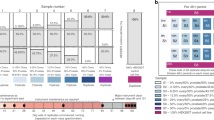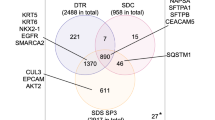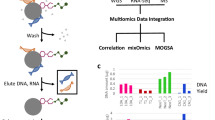Abstract
Here we present an optimized workflow for global proteome and phosphoproteome analysis of tissues or cell lines that uses isobaric tags (TMT (tandem mass tags)-10) for multiplexed analysis and relative quantification, and provides 3× higher throughput than iTRAQ (isobaric tags for absolute and relative quantification)-4-based methods with high intra- and inter-laboratory reproducibility. The workflow was systematically characterized and benchmarked across three independent laboratories using two distinct breast cancer subtypes from patient-derived xenograft models to enable assessment of proteome and phosphoproteome depth and quantitative reproducibility. Each plex consisted of ten samples, each being 300 μg of peptide derived from <50 mg of wet-weight tissue. Of the 10,000 proteins quantified per sample, we could distinguish 7,700 human proteins derived from tumor cells and 3100 mouse proteins derived from the surrounding stroma and blood. The maximum deviation across replicates and laboratories was <7%, and the inter-laboratory correlation for TMT ratio–based comparison of the two breast cancer subtypes was r > 0.88. The maximum deviation for the phosphoproteome coverage was <24% across laboratories, with an average of >37,000 quantified phosphosites per sample and differential quantification correlations of r > 0.72. The full procedure, including sample processing and data generation, can be completed within 10 d for ten tissue samples, and 100 samples can be analyzed in ~4 months using a single LC-MS/MS instrument. The high quality, depth, and reproducibility of the data obtained both within and across laboratories should enable new biological insights to be obtained from mass spectrometry-based proteomics analyses of cells and tissues together with proteogenomic data integration.
This is a preview of subscription content, access via your institution
Access options
Access Nature and 54 other Nature Portfolio journals
Get Nature+, our best-value online-access subscription
$29.99 / 30 days
cancel any time
Subscribe to this journal
Receive 12 print issues and online access
$259.00 per year
only $21.58 per issue
Buy this article
- Purchase on Springer Link
- Instant access to full article PDF
Prices may be subject to local taxes which are calculated during checkout




Similar content being viewed by others
References
Zhang, B. et al. Proteogenomic characterization of human colon and rectal cancer. Nature 513, 382–387 (2014).
Mertins, P. et al. Proteogenomics connects somatic mutations to signaling in breast cancer. Nature 534, 55–62 (2016).
Zhang, H. et al. Integrated proteogenomic characterization of human high-grade serous ovarian cancer. Cell 166, 755–765 (2016).
Ntai, I. et al. Integrated bottom-up and top-down proteomics of patient-derived breast tumor xenografts. Mol. Cell. Proteomics 15, 45–56 (2016).
Geiger, T., Wehner, A., Schaab, C., Cox, J. & Mann, M. Comparative proteomic analysis of eleven common cell lines reveals ubiquitous but varying expression of most proteins. Mol. Cell. Proteomics. 11, M111.014050 (2012).
Coscia, F. et al. Integrative proteomic profiling of ovarian cancer cell lines reveals precursor cell associated proteins and functional status. Nat. Commun. 7, 1–14 (2016).
Geiser, L., Dayon, L., Vaezzadeh, A. R. & Hochstrasser, D. F. Shotgun proteomics: a relative quantitative approach using off-gel electrophoresis and LC-MS/MS. Methods Mol. Biol. 681, 459–472 (2011).
Dwivedi, R. C. et al. Practical implementation of 2D HPLC scheme with accurate peptide retention prediction in both dimensions for high-throughput bottom-up proteomics. Anal. Chem. 80, 7036–7042 (2008).
Gilar, M., Olivova, P., Daly, A. E. & Gebler, J. C. Orthogonality of separation in two-dimensional liquid chromatography. Anal. Chem. 77, 6426–6434 (2005).
Delmotte, N., Lasaosa, M., Tholey, A., Heinzle, E. & Huber, C. G. Two-dimensional reversed-phase × ion-pair reversed-phase HPLC: an alternative approach to high-resolution peptide separation for shotgun proteome analysis. J. Proteome Res. 6, 4363–4373 (2007).
Song, C. et al. Reversed-phase-reversed-phase liquid chromatography approach with high orthogonality for multidimensional separation of phosphopeptides. Anal. Chem. 82, 53–56 (2010).
Wang, Y. et al. Reversed-phase chromatography with multiple fraction concatenation strategy for proteome profiling of human MCF10A cells. Proteomics 11, 2019–2026 (2011).
Mertins, P. et al. Integrated proteomic analysis of post-translational modifications by serial enrichment. Nat. Methods 10, 634–637 (2013).
Batth, T. S., Francavilla, C. & Olsen, J. V. Off-line high-pH reversed-phase fractionation for in-depth phosphoproteomics. J. Proteome Res. 13, 6176–6186 (2014).
Ong, S. E. & Mann, M. Mass spectrometry-based proteomics turns quantitative. Nat. Chem. Biol. 1, 252–262 (2005).
Rauniyar, N. & Yates, J. R. Isobaric labeling-based relative quantification in shotgun proteomics. J. Proteome Res. 13, 5293-5309 (2014).
Geiger, T., Cox, J., Ostasiewicz, P., Wisniewski, J. R. & Mann, M. Super-SILAC mix for quantitative proteomics of human tumor tissue. Nat. Methods 7, 383–385 (2010).
Molina, H. et al. Temporal profiling of the adipocyte proteome during differentiation using a five-plex SILAC based strategy. J. Proteome Res. 8, 48–58 (2009).
Bantscheff, M., Schirle, M., Sweetman, G., Rick, J. & Kuster, B. Quantitative mass spectrometry in proteomics: a critical review. Anal. Bioanal. Chem. 389, 1017–1031 (2007).
Rauniyar, N. & Yates, J. R. III Isobaric labeling-based relative quantification in shotgun proteomics. J. Proteome Res. 13, 5293–5309 (2014).
Ross, P. L. et al. Multiplexed protein quantitation in Saccharomyces cerevisiae using amine-reactive isobaric tagging reagents. Mol. Cell. Proteomics 12, 1154–1169 (2004).
Thompson, A. et al. Tandem mass tags: a novel quantification strategy for comparative analysis of complex protein mixtures by MS/MS. Anal. Chem. 75, 1895–1904 (2003).
Pichler, P. et al. Peptide labeling with isobaric tags yields higher identification rates using iTRAQ 4-plex compared to TMT 6-plex and iTRAQ 8-plex on LTQ Orbitrap. Anal. Chem. 82, 6549–6558 (2010).
Raso, C. et al. Characterization of breast cancer interstitial fluids by TmT labeling, LTQ-Orbitrap Velos mass spectrometry, and pathway analysis. J. Proteome Res. 11, 3199–3210 (2012).
Werner, T. et al. Ion coalescence of neutron encoded TMT 10-plex reporter ions. Anal. Chem. 86, 3594–3601 (2014).
Mertins, P. et al. Ischemia in tumors induces early and sustained phosphorylation changes in stress kinase pathways but does not affect global protein levels. Mol. Cell. Proteomics. 13, 1690–1704 (2014).
Svinkina, T. et al. Deep, quantitative coverage of the lysine acetylome using novel anti-acetyl-lysine antibodies and an optimized proteomic workflow. Mol. Cell. Proteomics 14, 2429–2440 (2015).
Böhm, G. et al. Low-pH solid-phase amino labeling of complex peptide digests with TMTs improves peptide identification rates for multiplexed global phosphopeptide analysis. J. Proteome Res. 14, 2500–2510 (2015).
Wiktorowicz, J. E., English, R. D., Wu, Z. & Kurosky, A. Model studies on iTRAQ modification of peptides: sequence-dependent reaction specificity. J. Proteome Res. 11, 1512–1520 (2012).
Thingholm, T. E., Palmisano, G., Kjeldsen, F. & Larsen, M. R. Undesirable charge-enhancement of isobaric tagged phosphopeptides leads to reduced identification efficiency. J. Proteome Res. 9, 4045–4552 (2010).
Karp, N. A. et al. Addressing accuracy and precision issues in iTRAQ quantitation. Mol. Cell. Proteomics 9, 1885–1897 (2010).
Savitski, M. M. et al. Measuring and managing ratio compression for accurate iTRAQ/TMT quantification. J. Proteome Res. 12, 3586–3598 (2013).
Ting, L., Rad, R., Gygi, S. P. & Haas, W. MS3 eliminates ratio distortion in isobaric multiplexed quantitative proteomics. Nat. Methods 8, 937–940 (2011).
May, J. C. & McLean, J. A. Ion mobility-mass spectrometry: time-dispersive instrumentation. Anal. Chem. 87, 1422–1436 (2014).
Pfammatter, S., Bonneil, W. & Thibault, P. Improvement of quantitative measurements in multiplex proteomics using high-field asymmetric waveform ion mobility spectrometry. J. Proteome Res. 15, 4653 (2016).
Ibrahim, Y. M. et al. New frontiers for mass spectrometry based upon structures for lossless ion manipulations. Analyst 142, 1010–1021 (2017).
Shadforth, I. P., Dunkley, T. P., Lilley, K. S. & Bessant, C. i-Tracker: for quantitative proteomics using iTRAQ. BMC Genomics 6, 145–150 (2005).
Rappsilber, J., Mann, M. & Ishihama, Y. Protocol for micro-purification, enrichment, pre-fractionation and storage of peptides for proteomics using StageTips. Nat. Protocols 2, 1896–1906 (2007).
Rodriguez, J., Gupta, N., Smith, R. D. & Pevzner, P. A. Does trypsin cut before proline? J. Proteome Res. 7, 300–305 (2008).
Mertins, P. et al. iTRAQ labeling is superior to mTRAQ for quantitative global proteomics and phosphoproteomics. Mol. Cell. Proteomics 11, M111.014423 (2012).
Wenger, C. D. et al. Gas-phase purification enables accurate, multiplexed proteome quantification with isobaric tagging. Nat. Methods 8, 933–935 (2011).
Tabb, D. et al. Reproducibility of differential proteomic technologies in CPTAC fractionated xenografts. J. Proteome Res. 15, 691–706 (2016).
Hogrebe, A. et al. Benchmarking common quantification strategies for large-scale phosphoproteomics. Nat. Commun. 9, 1045 (2018).
Subramanian, A. et al. Gene set enrichment analysis: a knowledge-based approach for interpreting genome-wide expression profiles. Proc. Natl. Acad. Sci. USA 102, 15545–15550 (2005).
Acknowledgements
We thank M.J. Ellis of the Lester and Sue Smith Breast Center, the Dan L. Duncan Comprehensive Cancer Center and the Departments of Medicine and Molecular and Cellular Biology, Baylor College of Medicine, and S. Li of the Human and Mouse Linked Evaluation of Tumor Core, Division of Oncology, Washington University School of Medicine, for development of the breast xenograft samples used; and J. Snider and P. Erdmann-Gilmore for the large-scale preparation of the cryopulverized tumor tissue. We also thank S. Stein and S. Markey of the National Institutes of Science and Technology for insightful comments. This work was supported by grants from the National Cancer Institute (NCI) Clinical Proteomic Tumor Analysis Consortium ((CPTAC) to S.A.C. and M.A.G. at the Broad Institute of MIT and Harvard (1U24CA210986); to T.L. and R.D.S. at the Pacific Northwest National Laboratories (U24CA210955); to D.W.C., H.Z. and Z.Z. at Johns Hopkins University (U24CA210985); and to R.R.T. (U24CA160035). Proteomics work at PNNL described herein was carried out in the Environmental Molecular Sciences Laboratory, a U.S. Department of Energy (DOE) national scientific user facility located at PNNL in Richland, Washington. PNNL is a multiprogram national laboratory operated by the Battelle Memorial Institute for the DOE under contract DE-AC05-76RL01830. Research reported in this publication was supported by a Washington University Institute of Clinical and Translational Sciences grant (UL1 TR000448) from the National Center for Advancing Translational Sciences (NCATS) of the National Institutes of Health (NIH). The content is solely the responsibility of the authors and does not necessarily represent the official view of the NIH.
Author information
Authors and Affiliations
Contributions
Conceptualized and designed overall study: K.R.C., L.C.T., M.A. Gillette, P.M., and S.A.C. Led experimental and data analysis efforts at the performance sites: P.M., M.A. Gritsenko., S.A.C., K.K., D.R.M., K.R.C., D.J.C., M.A. Gillette, V.A.P., S.N.T., Z.Z., R.D.S., D.W.C., H.Z., and T.L. Developed PDX benchmarking reference material and distributed to all centers: S.R.D. and R.R.T. Tested and optimized aspects of the experimental protocol: D.J.C., F.M., H.K., L.C.T., M.A. Gritsenko, N.D.U., P.M., P.S., R.J.M., R.Z., S.N.T., and T.R.C. Analyzed the results: D.R.M., F.M., K.R.C., K.K., M.A.G., M.S., M.E.M., P.M., T.L., V.A.P., and Y.H. Wrote the manuscript: H.Z., L.C.T., M.A. Gillette, P.M., K.R.C., and S.A.C. Edited and revised aspects of the text: D.J.C., D.W.C., H.Z., K.K., L.C.T., R.D.S., S.N.T., T.L., V.A.P., Z.Z., R.R.T., and S.R.D.
Corresponding author
Ethics declarations
Competing interests
The authors declare no competing interests.
Additional information
Publisher’s note: Springer Nature remains neutral with regard to jurisdictional claims in published maps and institutional affiliations.
Related links
1. Mertins, P. et al. Nature 534, 55–62 (2016) http://dx.doi.org/10.1038/nature18003
2. Zhang, H. et al. Cell 166, 755–765 (2016) http://dx.doi.org/10.1016/j.cell.2016.05.069
3. Mundt, F. et al. Cancer Res. 78, 2732–2746 (2018) http://dx.doi.org/10.1158/0008-5472.CAN-17-1990
Integrated supplementary information
Supplementary Figure 1 Uniqueness per basic RP fraction for identified peptides.
The pie charts depicts the distribution of the number of fractions a peptide has been detected per TMT plex, which is highly reproducible across laboratories. More the 75% of peptides have been detected in a single fraction. PDX models used in this study were approved by the institutional animal care and use committee at Washington University in St. Louis
Supplementary Figure 2 Efficiency of tryptic protein digestion.
Missed cleavage rate for proteome (A) and phosphoproteome (B) data. PDX models used in this study were approved by the institutional animal care and use committee at Washington University in St. Louis
Supplementary Figure 3 QC of basic reversed-phase chromatography.
A) Chromatogram of non-human peptide standard mix on the offline HPLC column. B) Example of 4 mg TMT-labeled sample fractionated on an Agilent Xtend Column
Supplementary Figure 4 Enrichment specificity for phosphopeptides.
The barchart depicts the percentage of phosphorylated peptides in the metal-affinity enriched fractions. PDX models used in this study were approved by the institutional animal care and use committee at Washington University in St. Louis
Supplementary Figure 5 Number of quantified proteins and phosphorylation sites across three laboratories.
The total number of quantified A) proteins and B) phosphorylation sites that could be assigned to human are illustrated as ‘UpSet’ plots (Lex, 2014). Horizontal bars indicate total number of proteins or phosphorylation sites detected by each laboratory; vertical bars depict the number of jointly detected features, as indicated by the layout matrix below. C) Comparison of detected and quantified human phosphosites in two TMT10-plexes acquired in PCC1. D) and E) Analogous plots for PCC2 and PCC3, respectively. PDX models used in this study were approved by the institutional animal care and use committee at Washington University in St. Louis
Supplementary Figure 6 Intra-plex correlations calculated on human+mouse and human-specific proteins and phosphorylation sites.
The box-whisker plots depict Pearson correlations of TMT ratios between intraplex replicate measurements, separated into human+mouse and human-specific. A) Intraplex correlations of human+mouse and B) human-specific proteins. C) Intraplex correlations of human+mouse and B) human-specific phosphorylation sites. Focusing on proteins and phosphorylation sites with human origin resulted in lower intraplex variability. PDX models used in this study were approved by the institutional animal care and use committee at Washington University in St. Louis
Supplementary Figure 7 Mouse-specific proteins contribute to high intra-plex variability.
The example shown illustrates the impact of mouse proteins on reproducibility. A) Scatter plot of protein TMT ratios from human+mouse proteins measured in two luminal intraplex replicate measurements. A small population of mouse proteins could not be reproducibly quantified in the two replicates, resulting in a moderate Pearson correlation of 0.78. B) After removal of mouse-specific proteins, the correlation significantly improves to 0.88. PDX models used in this study were approved by the institutional animal care and use committee at Washington University in St. Louis
Supplementary Figure 8 Impact of ratio count prefiltering on coverage and reproducibility.
Interplex correlations were calculated for different numbers of ratio counts (x-axis) required to calculate A) protein and B) phosphorylation site ratios, respectively. Median Pearson correlations as a function of minimal ratio counts are depicted as lines (left axis). Error bars correspond to +/- 1 M.A.D. The number of quantified features at different minimal ratio counts are illustrated as bar plots (right axis). Red dashed boxes indicate the number of minimal ratio counts providing the best trade-off between reproducibility and coverage, and were subsequently used in this study. PDX models used in this study were approved by the institutional animal care and use committee at Washington University in St. Louis
Supplementary Figure 9 Breast cancer-relevant proteins were consistently measured within and across laboratories.
Proteins for ESR1, FOXA1, GATA3, and TP53 show higher expression in luminal PDX samples, whereas proteins for EGFR and KRT5 are more abundant in basal PDX samples. Normalized TMT ratios of basal or luminal samples over a multimean denominator are shown. Red lines indicate the median of five measurements per TMT10-plex experiment with interquartile range bars. PDX models used in this study were approved by the institutional animal care and use committee at Washington University in St. Louis
Supplementary Figure 10 Biology is very well recapitulated between all three centers.
A) Normalized enrichment scores (NES) show high correlation with Pearson r’s of 0.96 to 0.97. The four most enriched genesets are color coded and include SMID_BREAST_CANCER_BASAL_UP and SMID_BREAST_CANCER_RELAPSE_IN_BONE_DN, which are enriched in proteins and phosphoproteins that are high in basal tumors, compared with the luminal tumors. Conversely, SMID_BREAST_CANCER_BASAL_DN and VANTEER_BREAST_CANCER_ESR1_UP are enriched in proteins and phosphoproteins that are high in luminal tumors (and therefore have low NES-scores). B) All the genesets containing the terms: “BASAL”, “ESR1”, or “LUMINAL” are plotted as three heat--maps; one for each search term. Red indicates a high NES score and blue a low NES score. Protein Characterization Center (PCC). PDX models used in this study were approved by the institutional animal care and use committee at Washington University in St. Louis
Supplementary information
Supplementary Text and Figures
Supplementary Figures 1–10
Rights and permissions
About this article
Cite this article
Mertins, P., Tang, L.C., Krug, K. et al. Reproducible workflow for multiplexed deep-scale proteome and phosphoproteome analysis of tumor tissues by liquid chromatography–mass spectrometry. Nat Protoc 13, 1632–1661 (2018). https://doi.org/10.1038/s41596-018-0006-9
Published:
Issue Date:
DOI: https://doi.org/10.1038/s41596-018-0006-9
This article is cited by
-
Frozen tissue coring and layered histological analysis improves cell type-specific proteogenomic characterization of pancreatic adenocarcinoma
Clinical Proteomics (2024)
-
Kinase inhibitor pulldown assay (KiP) for clinical proteomics
Clinical Proteomics (2024)
-
E-cadherin interacts with EGFR resulting in hyper-activation of ERK in multiple models of breast cancer
Oncogene (2024)
-
Artificial urinary biomarker probes for diagnosis
Nature Reviews Bioengineering (2024)
-
Decoding cancer insights: recent progress and strategies in proteomics for biomarker discovery
Journal of Proteins and Proteomics (2024)
Comments
By submitting a comment you agree to abide by our Terms and Community Guidelines. If you find something abusive or that does not comply with our terms or guidelines please flag it as inappropriate.



